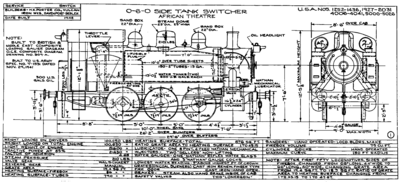SR USA class
|
USA class locomotive No.65 in Southern Railway livery | |||||||||||||||||||||||||||||||||
| |||||||||||||||||||||||||||||||||
| |||||||||||||||||||||||||||||||||
| |||||||||||||||||||||||||||||||||
| |||||||||||||||||||||||||||||||||
| Sources: [1] | |||||||||||||||||||||||||||||||||
The SR USA class were ex-United States Army Transportation Corps S100 Class steam locomotives purchased and adapted by the Southern Railway (SR) after the end of the Second World War to replace the LSWR B4 class then working in Southampton Docks.
Origins
The United States Army Transportation Corps built 382 S100 Class 0-6-0 for use in the Second World War. They were shipped to Great Britain in 1943 and stored awaiting the invasion of Mainland Europe. Most went overseas but some had hardly been used and remained in store at Newbury Racecourse after the war.[2] The SR needed to replace the ageing B4, D1 and E1 class tanks used in Southampton Docks. The locomotives needed to have a short wheelbase to negotiate the tight curves found in the dockyard, but be able to haul heavy freight trains as well as full-length passenger trains in the harbour area.[1] Fifteen locomotives were purchased on the recommendation of Oliver Bulleid (14 for traffic plus one for spares) and adapted for use in Britain. Other surviving members of the S100 Class found industrial uses in Great Britain with the National Coal Board, Longmoor Military Railway and Austin Motors.
Construction and adaptation
Thirteen of the SR locomotives were built at the Vulcan Iron Works in Wilkes-Barre, Pennsylvania in 1942. The remaining two were built by H. K. Porter, Inc of Pittsburgh.[2]

Following purchase they were fitted with steam heating, vacuum ejectors, sliding cab windows, additional lamp irons and new cylinder drain cocks.[1] Further modifications became necessary once the locomotives started to enter traffic, including large roof-top ventilators, British-style regulators (as built they had US-style pull-out ones), three rectangular cab-front lookout windows, extended coal bunkers, separate steam and vacuum brake controls and wooden tip-up seats. This meant that it took until November 1947 for the entire class to be ready for work.[1] Telephones were later installed on the footplate to improve communication on the vast network of sidings at Southampton.[1]
The class was allocated the British Railways (BR) power classification 3F following nationalisation in 1948
Numbering
Those purchased carried War Department numbers between 1264 and 1284, between 1952 and 1973 and 4326. Thirteen of the locomotives were re-numbered in a single sequence from 61-73 by SR but 4326 retained its War Department number instead of being renumbered 74. The locomotive used for spares was not numbered. After 1948 they were renumbered 30061-30074 by BR. Six examples were transferred to departmental (non-revenue earning) use in 1962/3 and renumbered DS233-DS238.
Livery
During the Second World War they were painted USATC black with white numbering and lettering 'Transportation Dept.' on the tank sides. Prior to nationalisation, the locomotives were painted in Southern black livery with 'Southern' in "Sunshine Yellow" lettering. The lettering on the tank sides was changed to 'British Railways' during 1948 as a transitional measure. Finally, the class was painted in BR Departmental Malachite livery, with BR crests on the watertank sides and numbers on the cab sides.
Operational details
.jpg)
For fifteen years they were used for shunting in Southampton Docks and although they performed well their austerity construction meant that they deteriorated very quickly.[1] Their steel fireboxes rusted and fatigued quickly, and this came to a head in 1951 when several had to have new fireboxes constructed.[1] They were replaced by British Rail Class 07 diesel-electric shunters, in 1962, when the first member of the class was withdrawn. The six departmental locomotives went to Redbridge Sleeper Depot, Meldon Quarry, Ashford wagon works (2 locomotives) and Lancing Carriage Works (2 locomotives). Other survivors were used for informal departmental purposes such as steam heating at Southampton or shunting at Eastleigh Motive Power Depot, before withdrawal. Nine examples remained in March 1967[3] and five of these survived until the end of steam on the Southern Region.[1]
Preservation
Four British examples have been preserved along with 2 being imported from Yugoslavia:
- 30064 Bluebell Railway - (Awaiting major overhaul)
- 30065 Kent and East Sussex Railway - (Operational)
- 30070 Kent and East Sussex Railway - (Undergoing major overhaul)
- 30072 Ribble Steam Railway - (Awaiting major overhaul)
- *30075 Shillingstone Railway Project - (Undergoing overhaul)[4]
- *30076 Shillingstone Railway Project - (Stored)[4]
Two locomotives built by the former Yugoslavian Railways to the S100 class design have been acquired for use on the Watercress Line and converted to British USA Class specifications. These are 62-669 (built 1960) now numbered 30075, and 62-521 (built 1954) now numbered 30076.
In fiction
An engine of this prototype appears in the Thomas & Friends TV Series as Rosie who was introduced in Series 10.
References
Further reading
- Sprenger, J. Howard; Robertson, K.J.; Sprenger, C.C. (23 July 2004). The Story of the Southern USA Tanks. Southampton: KRB Publications. ISBN 978-0-9544859-3-1.
- Ian Allan ABC of British Railways Locomotives. Winter 1959–1960.
External links
| Wikimedia Commons has media related to SR USA class. |
- USA 0-6-0T Southern E-Group
- SR USA Dock Tank SR "USA" class Dock Tank No.WD 1959 (BR 30064) Bluebell Railway